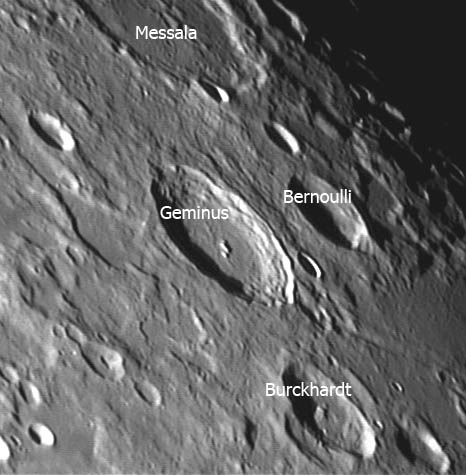
image by Vincent Bert
THIS IS A REPEAT OF THE MARCH 6, 2005 LPOD
Did you know that the diameter of Geminus is one kilometer larger than Tycho? 86 vs 85 km. Tycho is one of the best studied lunar craters because it is relatively large, but more importantly it is young (about 100 m.y.) and has the largest ray system on the Moon. Geminus is also young, but no radiometric date is available and its lack of a ray system means that it is Erastothenian in stratigraphic age – probably more than 2 b.y. old. Geminus is neglected, but Vince’s excellent image with his trusty orange C8 reveals Geminus to be a respectable complex crater with a sharp rim crest, originally terraced walls that are now muted, and a few low central peaks. Nearby are some other noteworthy sights. Immediately below Geminus is Burckhardt with its ears of overlapped craters. And notice that south and east of Geminus there is slight scarp with the terrain to the south being slightly lower and smoother. The scarp is the 1075 km diameter Geminus rim of the Crisium impact basin, and the smooth terrain probably is old basalt that has lost its dark hue. Finally, look at the interesting floor of Messala – just to the left of the “M” is a slight mound. A second, steeper mound appears NE of Bernoulli and SE of Messala – I haven’t looked at this feature on other images to see what it is. I am impressed with the features of interest that show up on this image from one of the early modern amateur telescopes!
Technical Details:
16 day old moon. Orange Tube C8 + 2X Barlow + Toucam Pro; 280 frames from 600. Imaged from Vincent’s apartment balcony, Solana Beach, CA
Related Links:
Rukl Plate 16
Yesterday's LPOD: A Nearly New Rille
Tomorrow's LPOD: Out the Porthole
COMMENTS?
Register, Log in, and join in the comments.



